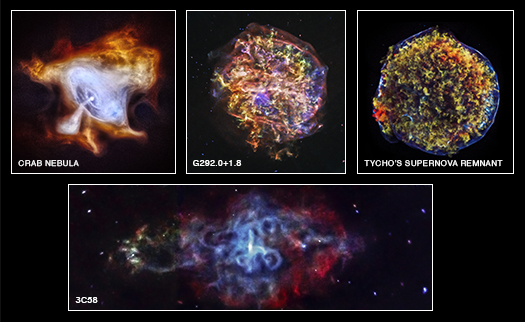
You might have heard that much of the material making up the world around us was forged in the hot bellies of massive stars. But how do we know this? We can't send probes to investigate because there isn't a material on Earth that can withstand the immense heat inside a star without being vapourised.
Luckily for us (but not for the stars), every star over 8 times heavier than our Sun will eventually explode as a supernova. When this happens, all the star's innards are launched into space for everyone to see. A supernova explosion also makes rare elements like Gold, Titanium and Uranium and can briefly outshine an entire galaxy!
Each of these four fabulous photographs shows the remains of an exploded star - called a supernova remnant. The pictures were released by NASA's Chandra X-ray Observatory to celebrate the telescope's 15th birthday.
Chandra is a telescope that is specially designed to look at X-rays that come from very hot places and objects in the Universe - including exploded stars. Because the explosions have super-heated these stellar wreckages, they glow very brightly in X-ray light.
Since the Earth's atmosphere blocks X-rays from space, Chandra has to orbit high above it. It currently looks at the Universe up to an altitude of 140,000 km above the Earth. From this ideal position Chandra can create X-ray pictures with superb detail, allowing us to study the shape, movement and chemical make-up of supernova remnants.
Moving from left to right, the objects are The Crab Nebula, G292.0+1.8, Tycho's Supernova and on the bottom is 3C58.
Cool Fact: Supernova remnants don't actually create any energy of their own, meaning their supply will eventually run out and each of these beautiful objects will fade away until they're invisible. But don't worry, they will last many thousands of years.
Watch the video podcast
(July 22, 2014)
Do you want to learn more about this topic?
Visit the Chandra field guide or send us your questions in an email: cxcpub@cfa.harvard.edu
In cooperation with Space Scoop: Bringing news from across the Universe to children all around the world. Universe Awareness and the Chandra X-ray Observatory
| Children & Online Privacy |



